|
|
| Swine Flu and Correctional Security |
| By William Sturgeon |
| Published: 05/04/2009 |
 Editors note: Corrections.com author, William Sturgeon, is an emergency preparedness and counterterrorism planning expert. He has more than 35 years of experience in the criminal justice field, and has managed security operations for sheriffs’ offices and correctional agencies across the United States.
Editors note: Corrections.com author, William Sturgeon, is an emergency preparedness and counterterrorism planning expert. He has more than 35 years of experience in the criminal justice field, and has managed security operations for sheriffs’ offices and correctional agencies across the United States.
While the extent of the Swine Flu / H1N1 Virus, is still unknown, those of us in the field of corrections need to begin implementing our policies for Pandemic and/or non-emergency medical events. Some of the steps that I am recommending you take immediately are what I would do if I were operating an agency or institution. I am approaching this from a security-operations standpoint, not from a medical or political standpoint. Operating corrections, detention and juvenile facilities requires us, at times, to take preemptive actions to ward-off problems. Mitigating the effects of contagious flu is, I believe, one of those times. Correctional institutions are “close contact” environments and are ripe for the spreading of the disease. From a security-operations standpoint, I would recommend that agencies, and institutions, both adult and juvenile, consider the following for implementation:
The N1H1 Virus/Swine Flu could easily overtake correctional and/or any close environment because it is spread by person-to-person contact. Taking preemptive precautions is, in my opinion, good correctional practice. Perhaps there are those who might disagree with me and would wait until either offenders or staff become infected with the H1N1 Virus or the Government declares a Pandemic. My response to those who disagree with my preemptive advice is to think about the last time your facility had an outbreak of Lice or Scabies and how quickly it spread through the facility. Corrections presents a “unique” living environment where contagious diseases can spread, if unchecked, throughout the entire offender population and staff very quickly. It is also crucial to communicate the most current information about the H1N1 Virus to the offender population and staff. If, in fact, this H1N1 Virus does become a real Pandemic, it will drastically affect the operations of correctional facilities worldwide. While there is still time, I suggest that all correctional agencies and facilities critically review their Pandemic Plans. When conducting the review, I would recommend that particular attention be paid to operating with seriously reduced staffing for a long period of time. The reduced staffing would be in every department, from security to foodservice. I hope that this is not the Pandemic that the Government and others have been warning us about, but the field of corrections cannot take that chance. Corrections MUST err on the side of caution, in my opinion. For more information about the Health Issues associated with Swine Flu/H1N1 Virus, contact your local/state health department and/or checkout these web sites: Red Cross Pandemic Flu CDC Flu Google Map - Flu web site Other articles by this author |
Comments:
Login to let us know what you think
MARKETPLACE search vendors | advanced search

IN CASE YOU MISSED IT
|


I believe this is a case of, "Chicken Little." Flu (regardless of strain) kills 36,000 people annually in the US alone. We cannot live life without risk. Minimizing risk is one thing...overstating the threat is another. I have lived my entire life of 50 years at the red-level, let alone orange or yellow. I am sick of all the fear - mongering and overstating of the issue.
Great article - the potential for a pandemic to reak havoc in correctional facilities world-wide is greatly under estimated. Keep up the great work. Colin Rosewarne Victoria, Australia.